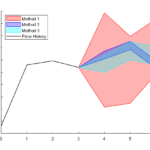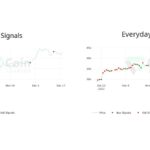Learn your first steps to earning
GENERAL TERMS
Future
Future and history points could be either in days or hours according to your preferred precision.
History
History slider controls how far back in the past you want to include in your model.
Econometrics
A well understood, quick and effective family of models. They are based on economic theory, mathematics, and statistics. Econometrics has been effectively used in the last decades to study time series
Spectrum Analysis
Singular Spectrum Analysis relies on decomposing coin dynamics into several components (defined by the components slider) and predicts each component separately.
Neural Networks
Deep neural networks are known for their efficiency in extracting features in the data and non-linear dependencies.
Features and options
-
Cryptocurrency Bar
Click on the cryptocurrency you want to model and predict its price.
-
Price History
- Type of Data: For very short term predictions you should use the hourly price history, this will give you data precision in minutes and ability to predict prices for up to 30 hours, minute by minute.
- If you are interested in short term or intermediate term predictions, use the daily price history.
- Notice that you can’t select both hourly and daily data at the same time. Also, Market sentiment is not available when you choose hourly data.
- Historical Points: Determines how many historical data you want to incorporate in your model. More data is not always better. In cryptocurrency market with highly changing dynamics, fewer historical points usually provide better predictions, while in more stable markets, more data points can give more precise predictions.
-
Market Sentiment
- The third data source is market sentiment, this data is created through sentiment analysis of millions of social media posts.
- These posts are collected thousands per day, then they are strictly filtered to keep only opinions of cryptocurrency traders and enthusiasts, then classified to positive and negative posts.
- Market sentiment data improves predictions of cryptocurrency markets that are highly influenced by its supporter and during the time of social media hypes.
- Named Entity Recognition: Recognizing name entities is an additional processing of social media posts that removes common English words and identifies what parts of the text constitute a cryptocurrency names, organization names, countries, persons, etcetera.
- Weigh by post influence: Coincharted implements an algorithm that uses a combination of social media reactions, for example, the number of likes and shares of a post to determine what posts are more important than others and disregard non influencing posts.
- It’s recommended to try the price prediction with each of these features on and off and see which setting gives you more accurate price predictions.
-
Econometrics
- The main assumption in Econometrics is that everyday price is a combination of yesterday’s price and a random component.
- It gets much more complicated than that, but even for highly volatile cryptocurrencies, this assumption holds to some extent.
- Overall, Econometric models -when fine-tuned- can provide accurate models and predictions with lower computational cost. So it’s recommended to start with Econometric models before advancing to more complicated ones
Options:
- Include seasonality changes: tries to separate the seasonal changes in prices for example, weekly or monthly cycles before predicting price changes. This helps to identify the real effect of each day’s price on the next day’s. Including seasonal changes usually gives more accurate predictions, However it is not always guaranteed that the algorithm can correctly separate these seasonal changes. If you don’t get accurate models, try turning this feature off.
- Use Automatic Optimizations: Coincharted makes daily optimization of econometric models, it’s recommended to keep this feature turn on.
-
Neural networks
- Neural networks use a structure of multiple layers of computations inspired by the human brain.
-
Spectrum Analysis
- Singular Spectrum Analysis relies on decomposing coin dynamics into several components (defined by the components slider) and predicts each component separately.
- Options:
- Components: Defines the number of components for SSA decomposition. More components are always better; however, it’s a good practice to keep the number of components less than half of the history points





